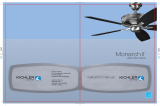
1. CAUTION – RISK OF SHOCK –
Disconnect Power at the main circuit breaker panel
or main fusebox before starting and during the
installation.
2. WARNING: This fixture is intended for installation in
accordance with the National Electrical Code (NEC)
and all local code specifications. If you are not familiar
with code requirements, installation by a certified
electrician is recommended.
3. WARNING: To reduce the risk of fire or electric shock,
use only the control provided with the fan.
4. WARNING: To reduce the risk of fire, electric shock,
or Personal Injury mount to an outlet box marked
“Acceptable For Fan Support of up to 15.9 kg (35 lbs)”.
For outlet box mounting, use mounting screws (and
lock washers) provided with the outlet box. Most
outlet boxes commonly used for the support of light
fixtures are not acceptable for fan support and may
need to be replaced. Due to the complexity of the
installation of this fan, a qualified licensed electrician
is strongly recommended.
5. WARNING: Chemical Burn Hazard. Keep batteries
away from children.; and
This product contains a lithium button/coin cell
battery. If a new or used lithium button/coin cell
battery is swallowed or enters the body, it can cause
severe internal burns and can lead to death in as little
as 2 hours. Always completely secure the battery
compartment. If the battery compartment does not
close securely, stop using the product, remove the
batteries, and keep it away from children. If you think
batteries might have been swallowed or placed inside
any part of the body, seek immediate medical attention.
a) The cells shall be disposed of properly, including
keeping them away from children; and
b) Even used cells may cause injury.
6. All wiring must be in accordance with the National
Electrical Code ANSI/NFPA 70 and local electrical
codes. Electrical installation should be performed by a
qualified licensed electrician.
READ AND SAVE THESE INSTRUCTIONS
SAFETY RULES
WARNING: FOR CANADA, THIS FAN MUST BE SECURED DIRECTLY TO THE BUILDING STRUCTURE / CEILING JOIST.
DON’T SECURE THIS FAN TO AN OUTLET BOX.
52" Vinea | 3





























